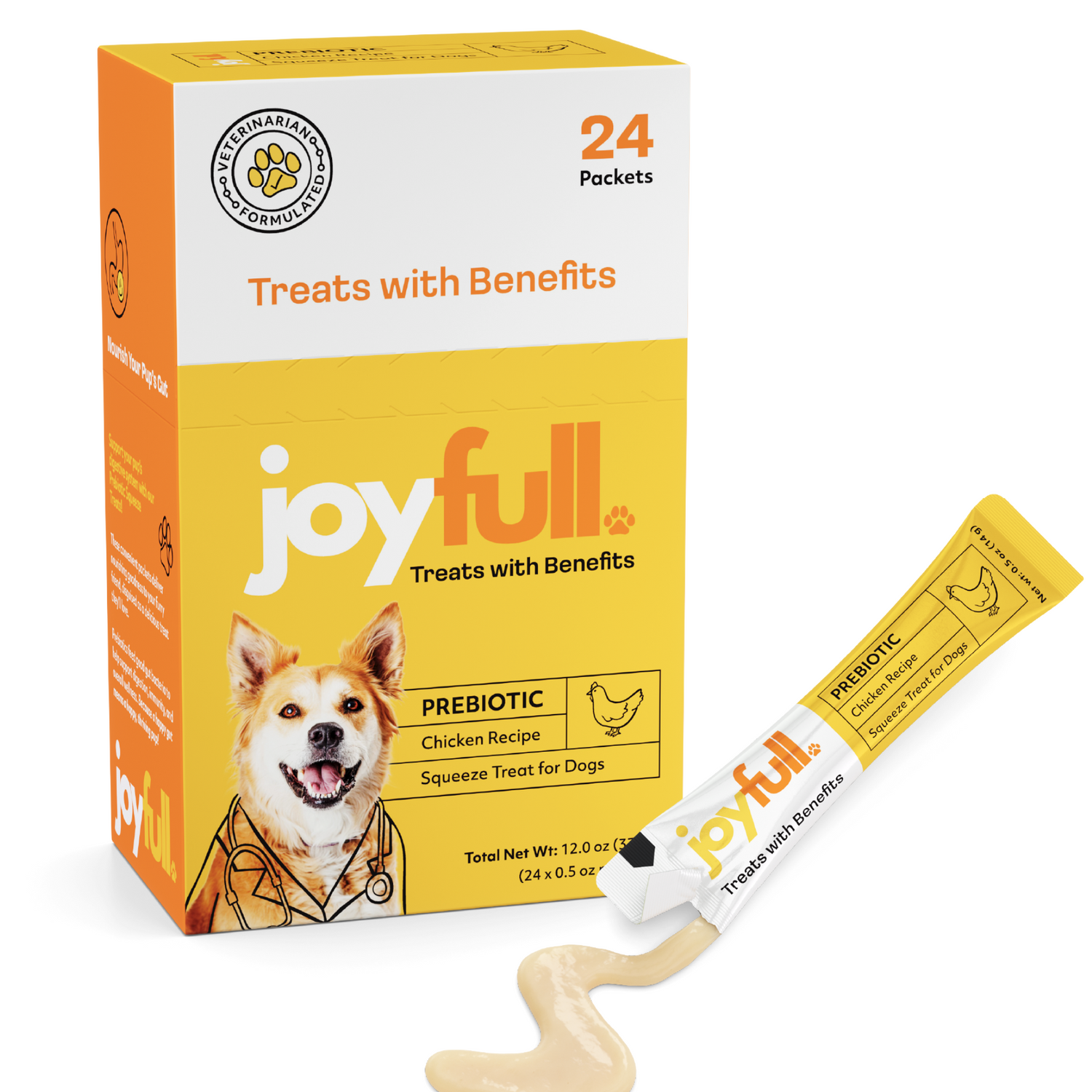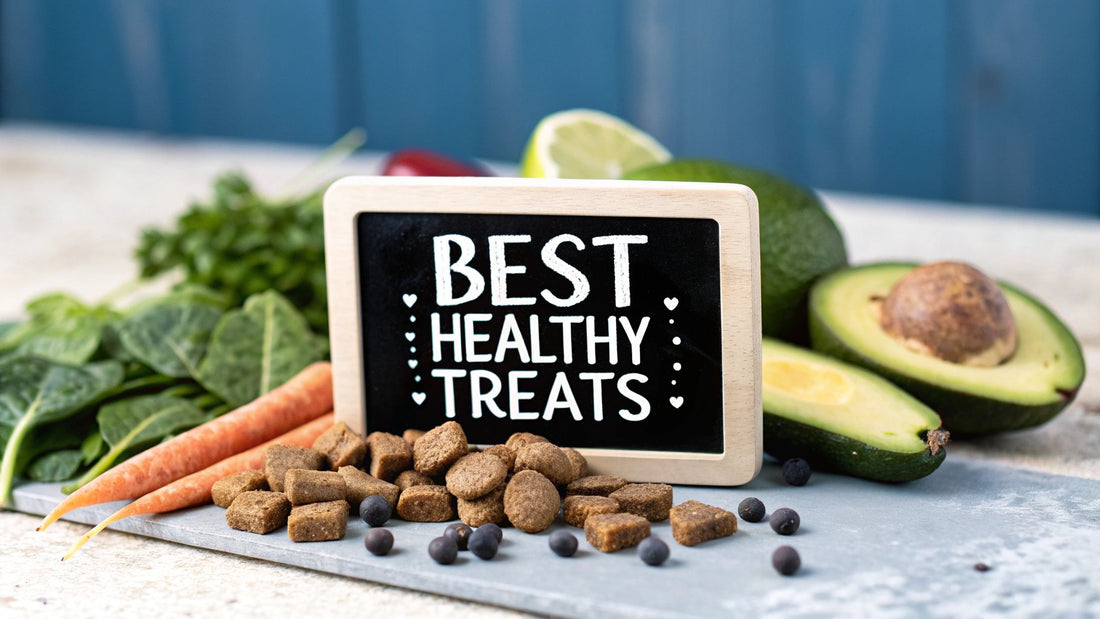
Finding the Best Healthy Dog Treat Brands
The best healthy dog treat brands have a simple philosophy: they use real, whole-food ingredients instead of pumping their products full of artificial fillers and mysterious by-products. They aren't afraid to show you exactly what's inside, offering transparent ingredient lists you can actually read and understand. No chemical preservatives, no weird additives—just genuinely nutritious snacks for your dog.
What Makes a Dog Treat Genuinely Healthy
Walking down the pet food aisle can be a sensory overload. Flashy bags and bold health claims scream for your attention from every shelf. But figuring out what makes a treat truly healthy is much simpler than it looks. It all comes down to the quality of the ingredients.
Think about it in terms of your own diet. You know that a fresh, grilled chicken breast is worlds apart from a highly processed chicken nugget, right? The same exact logic applies to your dog's snacks.
A genuinely healthy treat begins with a short, simple ingredient list. If you see recognizable whole foods like deboned chicken, sweet potato, or blueberries listed first, you’re on the right path. That kind of transparency is a hallmark of the best healthy dog treat brands.
Spotting Red Flags on the Label
On the flip side, some ingredients should be an immediate red flag. Vague, generic terms like “meat and bone meal” or “animal by-products” are often used to hide inconsistent, low-quality protein sources.
Here are a few other red flags to keep an eye out for:
- Artificial Colors and Flavors: Things like Red 40 or Yellow 5 add absolutely nothing of nutritional value. They’re just for show and can even trigger allergic reactions in some dogs.
- Chemical Preservatives: BHA, BHT, and ethoxyquin are synthetic preservatives that have been linked to potential health problems. Natural preservatives like tocopherols (vitamin E) are a much safer bet.
- Excessive Fillers: Corn, wheat, and soy are often used to bulk up treats cheaply. They offer very little nutritional benefit and can be tough for many dogs to digest.
Healthy vs Unhealthy Treat Ingredients at a Glance
To make it even simpler, here's a quick cheat sheet for scanning ingredient labels. Think of it as separating the good stuff from the junk.
| Ingredient Category | Look For These (Green Flags) | Avoid These (Red Flags) |
|---|---|---|
| Protein | Deboned Chicken, Beef, Lamb, Salmon | Meat Meal, Animal By-Products |
| Carbohydrates | Sweet Potato, Oats, Brown Rice, Peas | Corn, Wheat Gluten, Soy, White Flour |
| Preservatives | Tocopherols (Vitamin E), Rosemary Extract | BHA, BHT, Ethoxyquin, Propylene Glycol |
| Additives | Blueberries, Carrots, Turmeric, Flaxseed | Artificial Colors, Artificial Flavors, Sugar |
This table isn't exhaustive, of course, but it gives you a solid starting point for making smarter choices in the treat aisle.
It's clear that pet owners are catching on and demanding better options. The global dog treats market is expected to explode from USD 44.2 billion in 2025 to an incredible USD 336.3 billion by 2035. This massive growth is being driven by people just like you who want healthier, safer products for their four-legged family members.
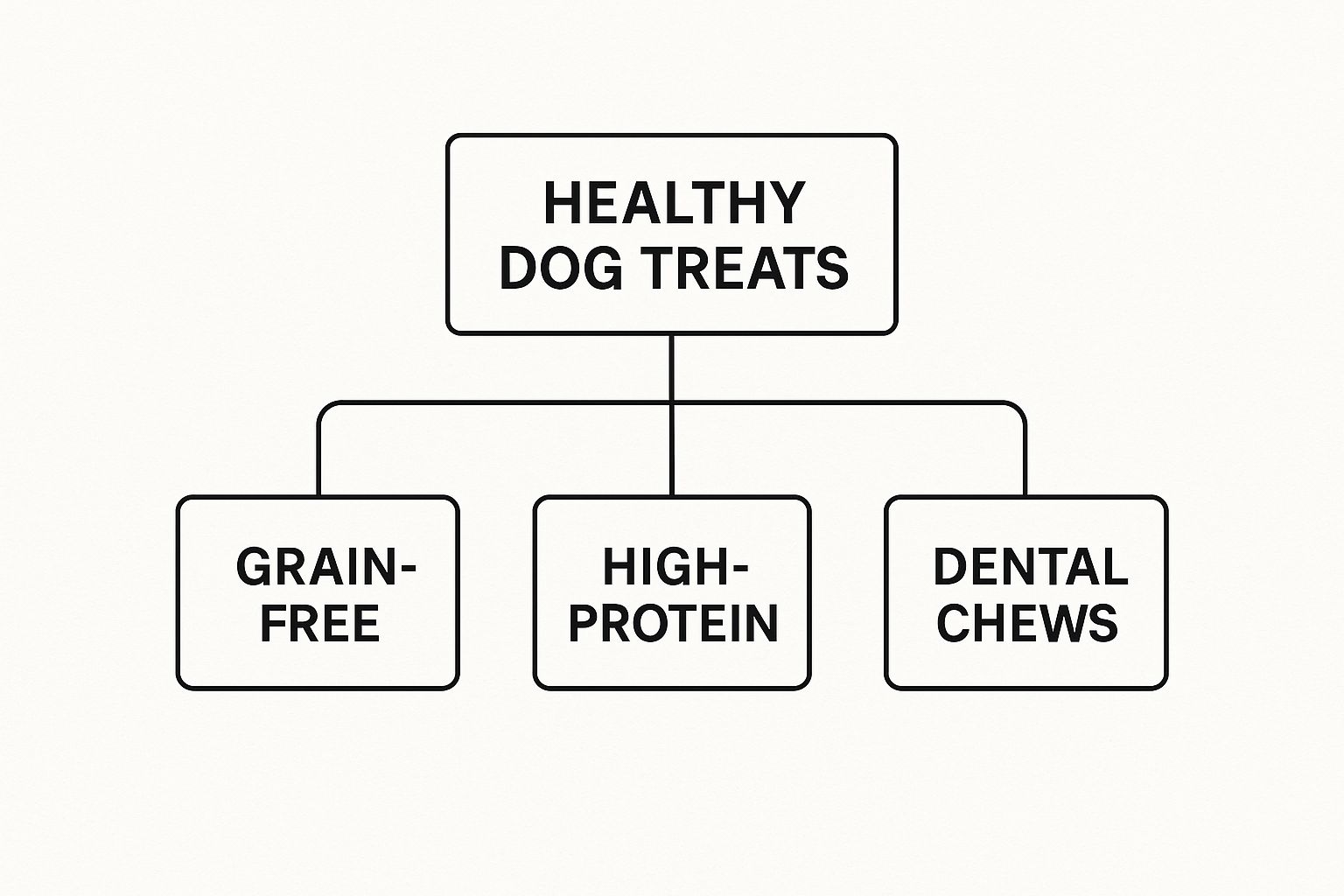
As you can see, pet parents are looking for specific benefits like grain-free recipes, high-protein snacks, and dental health support.
Of course, a truly healthy lifestyle goes beyond just treats. It also means creating a safe home environment, which includes everything from the cleaners you use to choosing pet-safe lawn care products.
If you'd like to dive deeper, you can learn more about finding the healthiest treats for dogs in our comprehensive guide.
The Core Components of a Quality Dog Treat

When you pick up a truly healthy dog treat, you’re holding more than just a quick snack. It’s better to think of it as a small, meticulously crafted nutritional package, designed from the ground up to support your dog’s health. The best healthy dog treat brands always build their products on three essential pillars.
These pillars are high-quality proteins, beneficial carbohydrates, and functional ingredients that add real value. Getting a handle on these three elements is what separates a genuinely nourishing treat from what’s essentially junk food with clever marketing. Let's dig into what each of these means for your dog.
The Power of Premium Protein
Protein is the absolute foundation of your dog's diet. It’s what they use to build and repair muscles, keep their organs functioning properly, and maintain healthy skin and a shiny coat. But here’s the thing: not all protein is created equal. The source and quality make a world of difference.
A top-tier treat will always list a specific, named animal protein right at the top of its ingredient list. You want to see clear, honest terms like "deboned chicken," "grass-fed beef," or "wild-caught salmon." That kind of transparency tells you exactly what you’re giving your best friend.
Now, compare that to the vague, fuzzy language you’ll find on lower-quality products:
- "Meat and bone meal": This is a rendered product made from mammal tissues. Its origin can be a mystery, and it’s often much less digestible for your dog.
- "Animal by-products": This could include anything from organs to feet. While some by-products can be nutritious, the term is a catch-all that lacks the specificity and guaranteed quality of whole meat.
Choosing treats with identifiable, high-quality protein sources ensures your dog gets the powerful, easy-to-absorb amino acids they need to thrive. It’s the difference between filling up their tank with premium fuel versus a low-grade substitute.
Beneficial Carbohydrates, Not Empty Fillers
Carbohydrates sometimes get a bad rap, but the right kind of carbs are an essential source of energy and dietary fiber for our dogs. The trick is learning to spot the difference between nutrient-dense complex carbs and the cheap, starchy fillers that do more harm than good.
Beneficial carbs provide a slow, steady release of energy and are fantastic for digestive health. Think of whole-food ingredients like sweet potatoes, pumpkin, peas, and oats. These are packed with vitamins, minerals, and fiber that help regulate your dog’s digestion and keep them feeling full and content. Pumpkin, for instance, is a superstar source of soluble fiber that can help with both constipation and diarrhea.
On the flip side, many mass-market treats are bulked up with cheap fillers. You'll often see these on the label:
- Corn and corn gluten meal
- Wheat and wheat gluten
- Soy
These ingredients offer very little nutritional value and are known to be common allergens for many dogs. They’re frequently the culprits behind skin irritation, digestive upset, and other sensitivities.
Value-Adding Functional Ingredients
The final piece of the puzzle is the inclusion of functional ingredients. These are specific additions that provide health benefits that go beyond basic nutrition. Think of it as adding a superfood boost to your own morning smoothie—it’s an extra layer of wellness.
A treat can be more than just a reward; it can be a tool for proactive wellness. Functional ingredients turn a simple snack into a small investment in your dog's long-term health, addressing everything from joint mobility to immune response.
This focus on wellness is exactly what’s driving the market. The natural dog treats segment, which puts ingredient quality first, was valued at a whopping USD 6.26 billion in 2023 and is expected to climb to over USD 14 billion by 2030. This incredible growth shows that pet owners are demanding more from what they feed their dogs. You can learn more about the booming natural dog treats market at grandviewresearch.com.
Here are a few examples of powerful functional ingredients to look for:
- Blueberries: Jam-packed with antioxidants to help support a healthy immune system.
- Flaxseed: A fantastic source of omega-3 fatty acids for promoting a shiny coat and healthy skin.
- Glucosamine and Chondroitin: Often added to support joint health, especially for senior dogs or very active breeds.
- Turmeric: Well-known for its natural anti-inflammatory properties.
When you spot these kinds of ingredients on a label, it’s a great sign. It shows the brand is thoughtfully creating its products not just to be tasty, but to actively contribute to your dog's overall well-being.
How to Read a Dog Treat Label Like a Pro
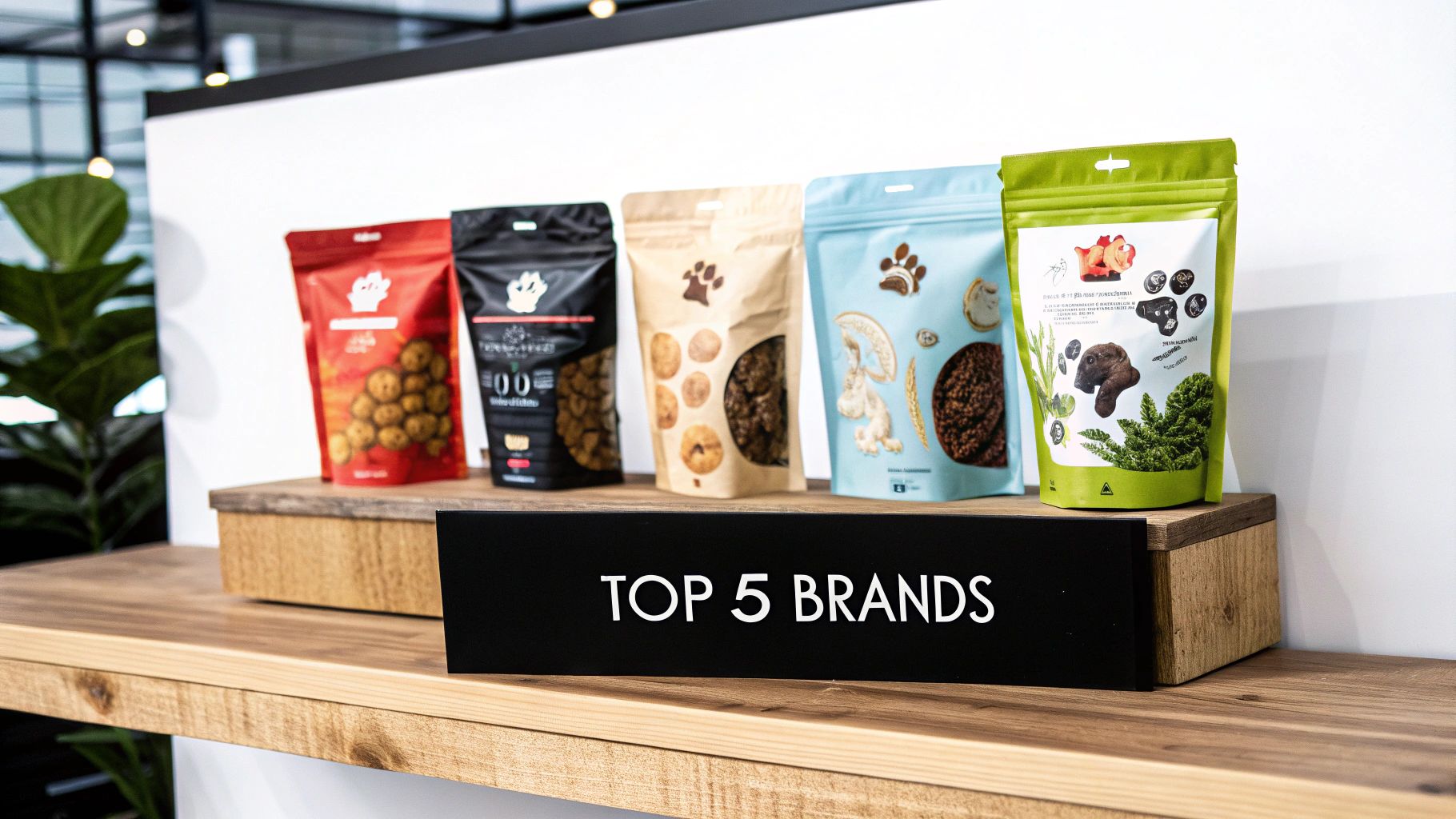
Walking down the pet store aisle can be overwhelming. Every bag seems to shout promises with pictures of happy dogs, but the real story is always tucked away in the small print on the back. If you want to find the best healthy dog treat brands, learning to read that label is the single most important skill you can have.
It’s what takes you from being a guessing consumer to a confident advocate for your dog's health. You stop falling for slick packaging and start seeing past the marketing noise to what really matters: what's actually inside the bag.
The First Five Rule
Here's a simple but powerful trick I always use: the “First Five” rule. Ingredients on any pet food label are listed by weight, starting with the heaviest. That means the first five ingredients make up the bulk of the treat. They tell you almost everything you need to know about its quality.
When you see a whole protein source like "deboned chicken" or "beef" at the top of the list, that’s a great sign. But if the top spots are clogged with fillers like corn, wheat, or vague "meat by-products," you can bet it’s a lower-quality product, no matter what the front of the bag says.
Cracking the Guaranteed Analysis Code
Right next to the ingredients, you’ll find a little box called the "Guaranteed Analysis." It looks like a bunch of boring numbers, but it’s actually a quick nutritional snapshot. It helps you match a treat to what your specific dog needs.
Let's break it down:
- Crude Protein (Min): This is the minimum amount of protein. For most dogs, a higher number is a good thing, as long as it’s coming from quality animal sources.
- Crude Fat (Min): Fat is essential for energy, but the amount should fit your dog's lifestyle. A couch potato pup needs less fat than a dog who joins you on weekend hikes.
- Crude Fiber (Max): This shows the indigestible stuff. A bit of fiber is fantastic for digestion, but a super high percentage often points to cheap fillers being used to bulk up the treat.
- Moisture (Max): This just tells you how much water is in the product. Crunchy biscuits will have very little, while soft, chewy treats will have a lot more.
When you combine the ingredient list with the guaranteed analysis, you get the whole story. The ingredients show you the quality of the nutrients, and the analysis shows you the quantity.
Ignoring the Marketing Buzzwords
The front of the bag is marketing territory. Brands use all sorts of appealing—but often meaningless—words to grab your attention. Knowing which words are just fluff helps you stay focused on the facts.
Words like "gourmet," "premium," or "natural flavor" sound great, but they have no official definition under the AAFCO (Association of American Feed Control Officials) guidelines. They’re designed to appeal to you, not to provide real information about the treat's quality.
For a more detailed breakdown, our guide on how to read dog food labels goes even deeper. The next time you're in the store, make it a habit to flip the bag over first. The ingredient panel is where the trustworthy, truly healthy dog treat brands prove their worth.
A Few Healthy Dog Treat Brands We Trust
Alright, now that you know how to read a label like a pro, let's talk about some brands that are doing things right. Walking down the pet aisle can be overwhelming, but it helps to have a mental shortlist of companies you can count on. These are brands that consistently walk the walk when it comes to quality, transparency, and creating treats that are actually good for your dog.
We're not just listing names here. We’ll dive into what makes each of these brands special—their core philosophy, the kinds of treats they make, and who they’re best for. Whether you've got a new puppy or a senior dog with achy joints, there's a great option out there.
The Honest Kitchen: Truly Human-Grade Goodness
The Honest Kitchen built its entire reputation on one game-changing idea: human-grade ingredients. It's a simple but powerful promise. Everything that goes into their treats, from the cage-free turkey to the apples, is handled in a human food facility. That means it meets the same safety standards as the food on your own plate.
This approach takes all the guesswork out of sourcing. For pet parents who want total peace of mind about where their dog's food comes from, this brand is a clear winner.
- Primary Protein Sources: They lean on top-tier proteins like cage-free chicken, ranch-raised beef, and turkey.
- Key Feature: The human-grade guarantee is their hallmark. It’s a level of quality control you just don't see very often in the pet food world.
- Best For: Dogs with sensitive tummies or owners who demand the absolute highest standard for ingredient safety.
Zuke's: Fuel for Your Next Adventure
Zuke's was born from the need for healthy, energizing treats for active dogs. Their famous Mini Naturals are a go-to for dog trainers for a reason—they’re tiny, low in calories, and dogs find them incredibly motivating.
The brand's whole philosophy is about using real, whole-food ingredients to power your dog's adventures. They skip the cheap fillers like corn, wheat, and soy, focusing instead on nutrient-dense recipes that provide sustained energy, not just empty calories.
- Primary Protein Sources: You'll commonly see chicken, salmon, duck, and peanut butter as the first ingredient.
- Key Feature: Their treats are perfectly sized for training. You can give your dog plenty of positive reinforcement without worrying about them packing on the pounds.
- Best For: Puppy training, obedience work, agility, or any time you need a high-value reward that won't spoil their dinner.
Wellness Natural Pet Food: Wholesome, Purposeful Nutrition
Wellness has been a trusted name in natural pet food for years, and for good reason. They offer an incredibly diverse range of treats, from soft puppy bites and crunchy biscuits to dental chews. This variety makes it simple to find something that perfectly suits your dog's age, size, and health needs.
Their motto is "uncompromising nutrition," and they live up to it. Every ingredient is chosen for a specific purpose. You’ll find recipes loaded with functional superfoods, like blueberries for a boost of antioxidants or flaxseed for its omega fatty acids.
When you choose a brand like Wellness, you’re not just giving your dog a treat. You're giving them a snack designed to support their whole-body health, one that complements their diet instead of undermining it.
The market for healthy treats is expanding fast, and this growth is fueled by pet parents like you. In fact, dogs are projected to hold 68.4% of the pet treat market share in 2025. This demand is pushing brands to innovate with specialized formulas like grain-free, single-protein, and dental options to meet our desire for clear health benefits. You can find more data about the expanding pet treats and chews market on futuremarketinsights.com.
Single-Ingredient Champions: The Power of Simplicity
For dogs with food allergies or serious sensitivities, less is almost always more. That’s why single-ingredient treats, like freeze-dried jerky, have become so popular. They completely eliminate the guesswork. The ingredient list is just one thing: beef liver, chicken breast, or salmon.
There are no additives, no preservatives, and zero fillers. Just pure, simple protein.
- Primary Protein Sources: Pretty much anything that can be freeze-dried or dehydrated—beef liver, chicken, salmon, and lamb lung are common favorites.
- Key Feature: Unbeatable purity. You know exactly what you’re feeding your dog, which is crucial for those on limited-ingredient diets.
- Best For: Dogs with known food sensitivities, those undergoing an elimination diet, or anyone who just wants a clean, high-protein reward.
To make comparing these great options a bit easier, here’s a quick breakdown of what makes each one stand out.
Top Healthy Dog Treat Brands Comparison
| Brand Name | Primary Protein Source | Key Feature/Benefit | Best For |
|---|---|---|---|
| The Honest Kitchen | Cage-free chicken, ranch-raised beef | 100% human-grade ingredients for ultimate safety | Dogs with sensitive stomachs; owners prioritizing transparency |
| Zuke's | Chicken, salmon, duck | Low-calorie, small-sized treats perfect for training | Active dogs, puppy training, and frequent rewarding |
| Wellness | Chicken, lamb, salmon | Wide variety of formulas with functional superfoods | Finding specific solutions for different life stages and needs |
| Single-Ingredient | Beef liver, chicken, salmon | Utterly simple and pure with no additives or fillers | Dogs with allergies or on limited-ingredient diets |
Ultimately, choosing any of these brands is a fantastic move. They all embody the principles of quality and transparency we’ve been talking about, making it that much easier to treat your best friend with confidence and love.
Choosing Treats for Dogs with Special Diets
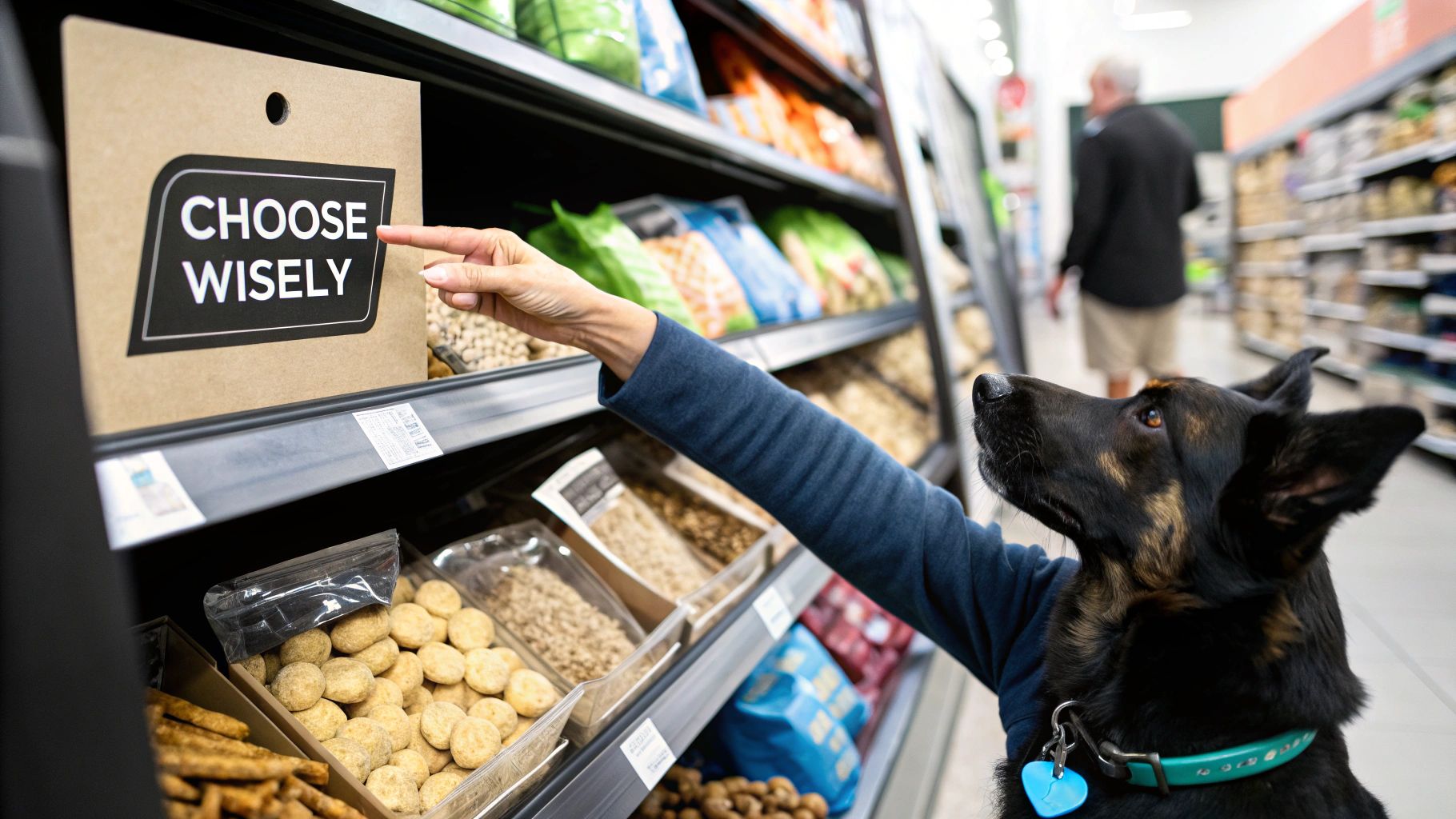
Let's be honest, not every treat works for every dog. Just like us, our pups can have unique dietary needs, whether it's a sensitive stomach, a pesky food allergy, a need to watch their weight, or just the gentle requirements of old age.
It might seem daunting at first, but figuring out what your dog needs is totally manageable. It all comes down to finding the perfect match for your best friend.
A lot of the time, sensitivities pop up in response to the ingredients dogs eat most often. You might be surprised to learn that common proteins like chicken, beef, and dairy are frequent culprits. Grains such as wheat and corn can also cause trouble for some dogs.
The key is to watch for the signs. Are they constantly scratching? Do they get chronic ear infections or have regular tummy troubles? Even something as simple as obsessive paw licking can be a clue. If you're seeing any of this, your first stop should always be a chat with your vet to get to the bottom of it.
Navigating Food Allergies and Sensitivities
If you and your vet suspect a food allergy, you'll likely hear about Limited Ingredient Diets (LID). The idea behind them is brilliant in its simplicity: fewer ingredients mean fewer potential triggers. These treats cut out all the noise and stick to the basics, making them a safe bet for dogs with sensitivities.
Another great strategy is to look for novel proteins. These are simply protein sources your dog probably hasn't eaten before. Because their immune system has no history with them, it's far less likely to react. It's a fantastic way to give your dog a delicious treat without the worry.
Some excellent novel proteins to try are:
- Duck: A rich, tasty protein that's often very easy on a dog's system.
- Lamb: This has been a go-to choice for sensitive dogs for a good reason—it works!
- Fish: Salmon or cod are not only new to many dogs' palates but also come loaded with omega-3s to help fight inflammation.
Focusing on treats with limited ingredients and new proteins is a game-changer. It’s a smart, targeted approach that the best healthy dog treat brands use to make sure every dog, no matter their needs, gets to enjoy a good snack.
Catering to Other Specific Health Needs
Allergies aren't the only thing to consider. Your dog's age, weight, and even their dental health should guide your choices when you're browsing the treat aisle.
Finding the right treat is an act of love. It means seeing your dog as an individual and choosing a snack that supports their specific health journey, whether they need fewer calories, a softer texture, or a grain-free formula.
For the pup who needs to lose a little weight, low-calorie treats are your best friend. Look for options made with lean proteins and fiber-rich veggies like pumpkin, which helps them feel satisfied. And for our wise old seniors with sensitive teeth, a soft-baked or freeze-dried treat is much easier to manage and enjoy.
Some dogs just feel better without grains in their diet. If that's your pup, treats made with alternatives like sweet potatoes or peas are a perfect fit. If you want to dive deeper into this, our guide on gluten-free dog treats has a ton of useful info.
At the end of the day, a little knowledge goes a long way. It gives you the confidence to find a treat that’s not just safe and healthy, but also absolutely delicious for your dog, whatever their needs may be.
Here's the rewritten section, designed to sound natural and human-written by an expert.
Healthy Treating is All About Moderation
You can pick out the highest-quality, most nutritious snack from the best healthy dog treat brands on the shelf, but if you give too many, you can still throw your dog's diet out of whack. Choosing a great treat is only half the job. The other, equally important half is knowing when and how to share them.
Think of it this way: a side of steamed broccoli is great for us, but if we ate only broccoli all day, our own nutrition would be a mess. It's the exact same for our dogs. Their main meals are the carefully balanced foundation, and treats should just be a little something extra.
Stick to the 10% Rule
To keep things simple, vets and nutritionists almost universally stand by the 10% Rule. It’s a super straightforward guideline that takes the guesswork out of treating.
The rule is simple: treats should never make up more than 10% of your dog’s total daily calories. The other 90% needs to come from their complete and balanced dog food.
Following this rule ensures treats stay what they’re supposed to be—a special reward, not a major food group. It's probably the single best thing you can do to prevent weight gain and make sure your dog isn't filling up on snacks instead of getting the essential nutrients from their dinner bowl.
Give Every Treat a Job
The easiest way to practice moderation is to treat with a purpose. Instead of handing out treats just because your dog is giving you "the eyes," use them as a tool to make your bond stronger and their mind sharper. This simple shift in thinking turns a snack into a meaningful interaction.
Here are a few ways to make treats more purposeful:
- Reward the Good Stuff: Use small, tasty treats to reinforce commands during training. This makes learning fun and tells your dog they're doing a great job.
- Build Positive Vibes: After a stressful vet visit or a nail trim, a special treat can help build a positive association with something they might not love.
- Make Them Think: Hide treats in a puzzle toy or a snuffle mat. This turns snack time into a brain game, which is a fantastic way to bust boredom.
When you start giving treats with intention, you naturally limit how many you're handing out while making your dog's life more interesting. It's a thoughtful approach that ensures every snack is doing more than just tasting good—it's reinforcing all the love and care you put into choosing those healthy treats in the first place.
Frequently Asked Questions About Dog Treats
Even when you feel like you've got a handle on what makes a great dog treat, questions inevitably pop up. It's only natural—we care more than ever about our dogs' health, and that curiosity is a great thing! Let's dive into some of the most common questions we hear from pet parents trying to navigate the world of healthy dog treats.
Are Grain-Free Treats Always Healthier for Dogs?
Not always, no. The grain-free trend started for a great reason: helping dogs with true grain allergies or sensitivities. For those specific pups, avoiding grains is non-negotiable for their comfort and digestive well-being.
For the vast majority of dogs, though, healthy whole grains like brown rice and oats are actually beneficial. They provide essential fiber, vitamins, and minerals. The real key isn't about including or excluding one ingredient category; it's about the overall quality of everything in the bag. A treat built around high-quality protein and veggies is an excellent choice, whether it contains some healthy grains or not.
How Can I Tell if a Brand Is Trustworthy?
Trustworthy brands aren't shy about the details. They're transparent.
Look for companies that openly share where their ingredients are sourced and where their products are made. They'll have information on their website about quality control and safety testing. A brand that's proud of its product wants you to know what's in it. If you see vague terms like "meat by-products" or "animal digest," that’s usually a red flag signaling lower-quality, mystery ingredients.
True quality comes from specificity. A trustworthy brand will proudly list "grass-fed beef" or "cage-free chicken," while a less reliable one might hide behind generic, undefined terms. This commitment to clarity is a key marker of the best healthy dog treat brands.
Can My Dog Eat Human Food as a Treat?
Some human foods get the green light, but many are a hard no. In moderation, small bits of carrot, green beans, or apple slices (just be sure to remove the seeds and core!) are perfectly fine.
The danger lies with the long list of toxic foods. Things like chocolate, grapes, onions, garlic, and anything containing the sweetener xylitol are absolute no-gos. When you're not 100% sure, the safest bet is to stick with treats made specifically for dogs or to get a quick confirmation from your vet.
What Is the Difference Between a Training Treat and a Regular Treat?
It really boils down to three things: size, calorie count, and allure.
Training treats are tiny, low-calorie powerhouses of flavor. They need to be extra delicious to keep your dog focused during a training session. Because you might give dozens in a short period, they have to be small enough that they don't lead to weight gain.
Regular treats, on the other hand, are typically larger and meant as a special, less frequent reward. Regardless of the type, both should always be made from the same high-quality, healthy ingredients. If you're looking for fun ways to reward your dog during practice, you could even try something like an interactive snack launcher for training.
At Joyfull, we believe your pet deserves the best. Our treats are crafted with clean ingredients and high-quality proteins, all reviewed by our veterinary advisor to ensure they support a happy, healthy life. Explore our better-for-you snacks at https://joyfullpet.com.
